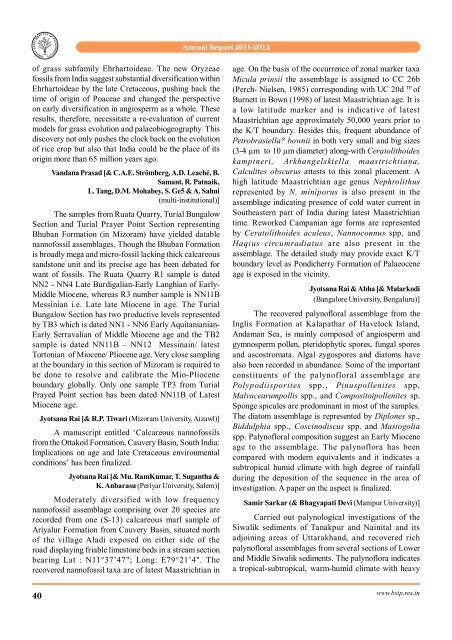Annual Report 2011-2012 - Birbal Sahni Institute of Palaeobotany
Annual Report 2011-2012 - Birbal Sahni Institute of Palaeobotany
Annual Report 2011-2012 - Birbal Sahni Institute of Palaeobotany
You also want an ePaper? Increase the reach of your titles
YUMPU automatically turns print PDFs into web optimized ePapers that Google loves.
EBIRBAL SAHNI INSTITUT<br />
1946<br />
OF PALAEOBOTANY<br />
<strong>Annual</strong> <strong>Report</strong> <strong>2011</strong>-<strong>2012</strong><br />
<strong>of</strong> grass subfamily Ehrhartoideae. The new Oryzeae<br />
fossils from India suggest substantial diversification within<br />
Ehrhartoideae by the late Cretaceous, pushing back the<br />
time <strong>of</strong> origin <strong>of</strong> Poaceae and changed the perspective<br />
on early diversification in angiosperm as a whole. These<br />
results, therefore, necessitate a re-evaluation <strong>of</strong> current<br />
models for grass evolution and palaeobiogeography. This<br />
discovery not only pushes the clock back on the evolution<br />
<strong>of</strong> rice crop but also that India could be the place <strong>of</strong> its<br />
origin more than 65 million years ago.<br />
Vandana Prasad [& C.A.E. Strömberg, A.D. Leaché, B.<br />
Samant, R. Patnaik,<br />
L. Tang, D.M. Mohabey, S. Ge5 & A. <strong>Sahni</strong><br />
(multi-institutional)]<br />
The samples from Ruata Quarry, Turial Bungalow<br />
Section and Turial Prayer Point Section representing<br />
Bhuban Formation (in Mizoram) have yielded datable<br />
nann<strong>of</strong>ossil assemblages. Though the Bhuban Formation<br />
is broadly mega and micro-fossil lacking thick calcareous<br />
sandstone unit and its precise age has been debated for<br />
want <strong>of</strong> fossils. The Ruata Quarry R1 sample is dated<br />
NN2 - NN4 Late Burdigalian-Early Langhian <strong>of</strong> Early-<br />
Middle Miocene, whereas R3 number sample is NN11B<br />
Messinian i.e. Late late Miocene in age. The Turial<br />
Bungalow Section has two productive levels represented<br />
by TB3 which is dated NN1 - NN6 Early Aquitanianian-<br />
Early Serravalian <strong>of</strong> Middle Miocene age and the TB2<br />
sample is dated NN11B – NN12 Messinain/ latest<br />
Tortonian <strong>of</strong> Miocene/ Pliocene age. Very close sampling<br />
at the boundary in this section <strong>of</strong> Mizoram is required to<br />
be done to resolve and calibrate the Mio-Pliocene<br />
boundary globally. Only one sample TP3 from Turial<br />
Prayed Point section has been dated NN11B <strong>of</strong> Latest<br />
Miocene age.<br />
Jyotsana Rai [& R.P. Tiwari (Mizoram University, Aizawl)]<br />
A manuscript entitled ‘Calcareous nann<strong>of</strong>ossils<br />
from the Ottakoil Formation, Cauvery Basin, South India:<br />
Implications on age and late Cretaceous environmental<br />
conditions’ has been finalized.<br />
Jyotsana Rai [& Mu. RamKumar, T. Sugantha &<br />
K. Anbarasu (Periyar University, Salem)]<br />
Moderately diversified with low frequency<br />
nann<strong>of</strong>ossil assemblage comprising over 20 species are<br />
recorded from one (S-13) calcareous marl sample <strong>of</strong><br />
Ariyalur Formation from Cauvery Basin, situated north<br />
<strong>of</strong> the village Aladi exposed on either side <strong>of</strong> the<br />
road displaying friable limestone beds in a stream section<br />
bearing Lat : N11°37’47"; Long: E79°21’4". The<br />
recovered nann<strong>of</strong>ossil taxa are <strong>of</strong> latest Maastrichtian in<br />
age. On the basis <strong>of</strong> the occurrence <strong>of</strong> zonal marker taxa<br />
Micula prinsii the assemblage is assigned to CC 26b<br />
(Perch- Nielsen, 1985) corresponding with UC 20d TP <strong>of</strong><br />
Burnett in Bown (1998) <strong>of</strong> latest Maastrichtian age. It is<br />
a low latitude marker and is indicative <strong>of</strong> latest<br />
Maastrichtian age approximately 50,000 years prior to<br />
the K/T boundary. Besides this, frequent abundance <strong>of</strong><br />
Petrobrasiella bownii in both very small and big sizes<br />
(3-4 µm to 10 µm diameter) along-with Ceratolithoides<br />
kamptneri, Arkhangelskiella maastrichtiana,<br />
Calculites obscurus attests to this zonal placement. A<br />
high latitude Maastrichtian age genus Nephrolithus<br />
represented by N. miniporus is also present in the<br />
assemblage indicating presence <strong>of</strong> cold water current in<br />
Southeastern part <strong>of</strong> India during latest Maastrichtian<br />
time. Reworked Campanian age forms are represented<br />
by Ceratolithoides aculeus, Nannoconnus spp. and<br />
Haqius circumradiatus are also present in the<br />
assemblage. The detailed study may provide exact K/T<br />
boundary level as Pondicherry Formation <strong>of</strong> Palaeocene<br />
age is exposed in the vicinity.<br />
Jyotsana Rai & Abha [& Malarkodi<br />
(Bangalore University, Bengaluru)]<br />
The recovered palyn<strong>of</strong>loral assemblage from the<br />
Inglis Formation at Kalapathar <strong>of</strong> Havelock Island,<br />
Andaman Sea, is mainly composed <strong>of</strong> angiosperm and<br />
gymnosperm pollen, pteridophytic spores, fungal spores<br />
and ascostromata. Algal zygospores and diatoms have<br />
also been recorded in abundance. Some <strong>of</strong> the important<br />
constituents <strong>of</strong> the palyn<strong>of</strong>loral assemblage are<br />
Polypodiisporites spp., Pinuspollenites spp,<br />
Malvacearumpollis spp., and Compositoipollenites sp.<br />
Sponge spicules are predominant in most <strong>of</strong> the samples.<br />
The diatom assemblage is represented by Diplones sp.,<br />
Biddulphia spp., Coscinodiscus spp. and Mastogolia<br />
spp. Palyn<strong>of</strong>loral composition suggest an Early Miocene<br />
age to the assemblage. The palyn<strong>of</strong>lora has been<br />
compared with modern equivalents and it indicates a<br />
subtropical humid climate with high degree <strong>of</strong> rainfall<br />
during the deposition <strong>of</strong> the sequence in the area <strong>of</strong><br />
investigation. A paper on the aspect is finalized.<br />
Samir Sarkar (& Bhagyapati Devi (Manipur University)]<br />
Carried out palynological investigations <strong>of</strong> the<br />
Siwalik sediments <strong>of</strong> Tanakpur and Nainital and its<br />
adjoining areas <strong>of</strong> Uttarakhand, and recovered rich<br />
palyn<strong>of</strong>loral assemblages from several sections <strong>of</strong> Lower<br />
and Middle Siwalik sediments. The palyn<strong>of</strong>lora indicates<br />
a tropical-subtropical, warm-humid climate with heavy<br />
40<br />
www.bsip.res.in

















